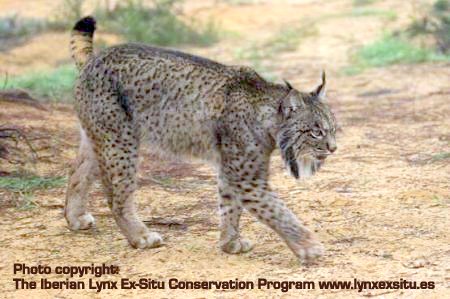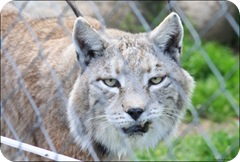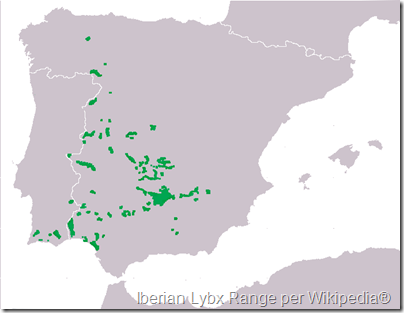
2009: I’d like to start the discussion about the Iberian lynx (Lynx pardinus) by looking at habitat, the distribution of this medium sized wild cat in Spain and Portugal which constitutes the Iberian Peninsula with Andorra, Gibraltar and a very small part of France. It is the most important topic for this wild cat.
The Iberian lynx looks like a smaller version of the Eurasian lynx (Lynx lynx),  while only about half his size-adult males weigh an average of 12.8 kg and females about 9.3 kg (Flickr photographer). His photo is to the right. I think it was taken in a Madrid reserve or zoo. The shoulder height is 60–70 cm. Please see: Description of the Eurasian Lynx.
while only about half his size-adult males weigh an average of 12.8 kg and females about 9.3 kg (Flickr photographer). His photo is to the right. I think it was taken in a Madrid reserve or zoo. The shoulder height is 60–70 cm. Please see: Description of the Eurasian Lynx.
Originally, the Iberian lynx used to be found throughout the peninsula although it would have preferred certain areas over others. Although adaptable, the lynx prefers areas of dense cover within a variable habitat type. The ideal landscape for this cat would be open forest and dense shrubs (for shelter) with open pasture to chase its favoured prey, rabbits. Although it has been forced to adapt to living in part wetlands, one of its last strongholds on the southwest coast of Spain (please see map below), the Coto Doñana.

Its wide-ranging habitat has changed forever. As we know the Iberian lynx is critically endangered (see the Red List logo-classification above). A look at the starkly reduced distribution of this cat tells us about one reason why – loss of habitat.

The above map presented on Wikipedia® seems to be well out of date if the IUCN Red List for Threatened Species™ (Red List) map is judged to be the better source material (which it will be). The map below is based on the Red List map and as can be seen the range is now two small areas marked in blue. It should be noted however that it is thought that the lynx is extinct in the other areas where it was found. This is not then a certainty but is probably the case.
| Marked Area | What It Means |
| Green Line | This encloses the wider area that contains fragmented habitat where this wild cat is believed to be extinct. You can zoom back to see the big picture |
| Red Line | This contains the wider area around the Parque Nacional de Doñana. The park is a place where the Iberian lynx is known to be found and the wider area where they are also found. |
| Blue Areas (2) | These are the areas where this wild cat is known to live. The population in the park is estimated at 24-33 and in the eastern Sierra Morena (the “stronghold”) 60-110 (2009). Please note that the effective population size (breeding adults) is much less at about 50 in the Sierra Morena. |


need to have some on the adaptations